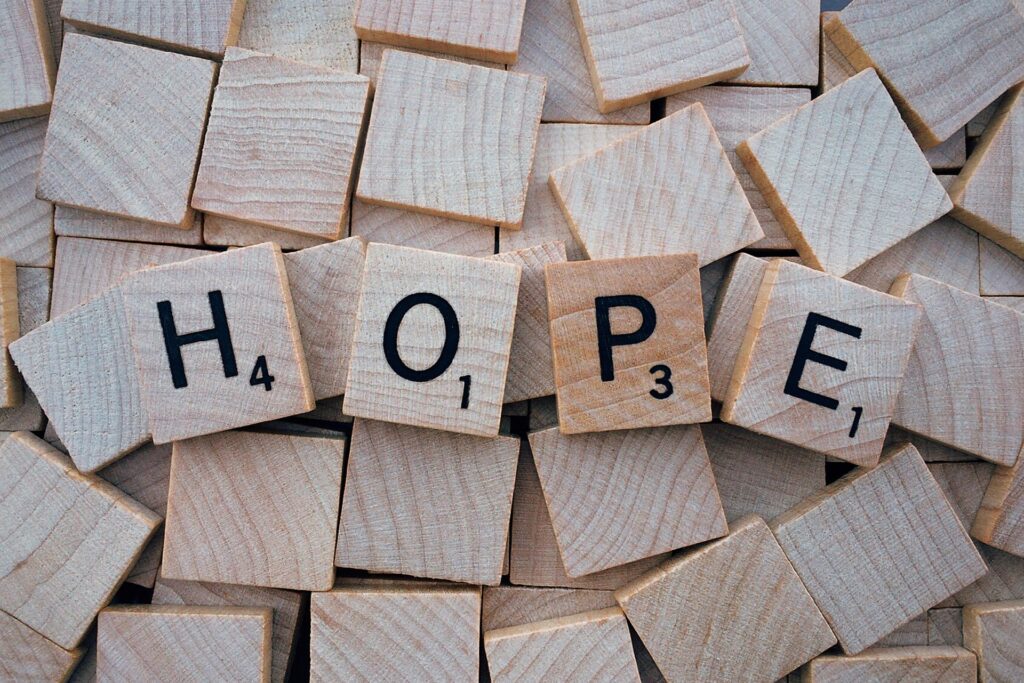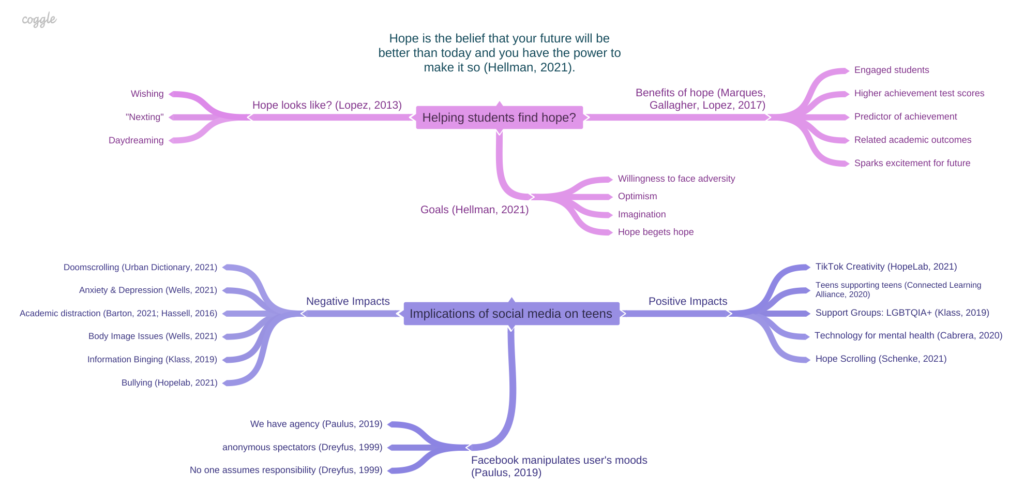
In August of 2018, I attended my first summer institute at my new teaching job. I was a brand-new change of career teacher, and I really did not fully understand the magnitude of the adventure I was embarking upon. My first day of training was mostly get to know you activities with the whole district staff, then we broke off into building meetings. This all seemed very run-of-the-mill, and I was looking forward to my second day of training. The second day of training was nothing like the first. The district brought in a consultant from Clarity Consulting, and we started a 3-hour training on “The Science of Hope.” This training has always stood out to me and when I was asked to pick an important personal value or ethical standard that was important to me professionally, hope was the first thing to come to mind.
When I reflect on that training, I realize that I walked out of the room filled with hope for the new career and pathway I had chosen to take in my life. After reading the assigned readings and reflecting on the module questions, hope came back to me as an important personal value. I feel it is essential that as a teacher I am filling my students with a sense of hope for their futures. Questions that might be included in an ethical audit are:
- With all the technology our students are inundated with, how are we helping them to sift through it all and still have hope?
- Are we helping our students to understand the impact that their media consumption is having on them?
Hope has many definitions, the one that stood out to me came from a TedTalk by Chan Hellman, PhD. He defined hope as “the belief that your future will be better than today and you have the power to make it so” (Hellman, 2021). How does hope tie in with technology and education? Since mid-March 2020, technology has been inextricably linked with education. Students and teachers have had to learn to navigate and integrate technology into all subjects and all learning styles. According to the American Academy of Child and Adolescent Psychiatry, by 2018 90% of 13–17-year-olds reported having used social media, 75% reported having at least one social media account and 51% reported visiting a social media site at least daily (2018).
Due to this information, I decided to select International Society for Technology in Education (ISTE) standard 7b to focus on, and address how I can partner with educators, leaders, students, and families to foster a culture of respectful online interactions and a healthy balance in their use of technology (ISTE, n.d.). To organize my thoughts, I made a mind map of hope, including the definition, what hope can do for students, and the implications social media is having on teens (see Figure 1).
Figure 1
Mind Map of Hope

It is my view that technology is unavoidable, when considering Campbell and Garner’s responses to technology, I have realized that my view is one of hope, which gives me an optimistic view of technology (2016). I know that technology is not going anywhere, and I believe that we can shape where technology goes, we have agency (Paulus, 2019). As technology is unavoidable, it is our job as educators to partner with all stakeholders to learn how to use the tools for social media and technology in general to generate hope for our students.
Hope is a powerful factor in any person’s life. Lopez states that hope can take many forms and often looks like wishing, “nexting” and even daydreaming (2013). When a person has hope, positive outcomes are more likely to happen for that person. People with hope are more apt to be willing to face adversity, they have optimism, imagination, and having hope begets more hope (Hellman, 2021). There are also positive outcomes directly related to education. According to Marques et al. (2017) students experience the following outcomes from having hope: students are more engaged, they have higher achievement scores, related academic outcomes, and excitement for the future. There are very clear benefits to people having hope and I believe that taking the time to teach students how to have hope is a worthy use of time.
Recently The Wall Street Journal started reporting on a series they titled “The Facebook Files.” The information that is coming from this reporting has been shocking for many people and led to a congressional hearing on September 30, 2021. The reporting that directly relates to hope and teenagers was released on September 24, 2021, with bombshell data regarding how teens feel when interacting with the social media app Instagram. The Wall Street Journal reported that 32% of teen girls said, “that when they felt bad about their bodies, Instagram made them feel worse” (Wells et. al., 2021). Boys have also been impacted with 14% reporting the same ( Wells et. al., 2021 ). This data was shocking on several levels but mostly because it was generated by internal research and the public perception was that Facebook and Instagram did nothing to make changes and improvements to help these teens.
A study by Hassell and Sukalich (2016) found a correlation between high social media usage and a person’s perceptions of their capabilities and performance, which can lead to a lower satisfaction with life. Another study conducted by Barton et. al. (2021) stated that all stakeholders, parents, students, and educators, need to be aware of the potential negative effects of social media on students’ academic performance. These studies, paired with the recent series published by The Wall Street Journal paint a very dim view of social media and the effects it is having on children, but there is hope that we can change this.
There is always hope, it is up to us as educators to work with all involved stakeholders to help bring that hope to students. Dreyfus (1999), in response to the nihilistic pull of the internet, states that “their teachers will have to foster those social practices that support strong identities.” In many cases this is already being done and there is always room for improvement. Teens themselves are starting to recognize the impact that social media is having on their lives and which platforms seem to be better for their mental health. In 2018 Stanford Medicine and Hopelab teamed up and completed an extensive research project with 1300 teenagers. The results of their findings give me hope for the future of our teens on social media.
According to the Stanford and Hopelab research, teens are starting to find strategies for managing their negative online experiences. Some of those reported methods include: taking breaks, reporting triggering content and curating their feeds (Rideout & Fox, 2018). Another key takeaway from Rideout and Fox is that students are on multiple platforms and use each one for a different reason. Twitter and YouTube are both referenced as places that teens go to cheer themselves up (Rideout & Fox, 2018). According to their research, teens with depression report that social media is very important to them because it allows them to express themselves creatively, get inspiration from others, and also to feel less alone (Rideout & Fox, 2018). TikTok is another app that young people have turned to as a creative outlet.
There is one clear take away from all of this research on hope and social media usage with teens: there are risks involved with allowing teens to be on social media, but there are also potential positives. There is hope, but we need to make sure that we are helping our students to find the hope. Educators and parents need to be very deliberate in teaching teens how to use social media and how to keep themselves safe online. We need to remind teens that there are multiple uses for social media and we also we need to make sure that we are making ourselves available when they interact with certain things online.
Additionally, we need to make sure that our students have resources available to them if they find themselves regularly having negative experiences online that are impacting their mental health. This can be done using the Triple E framework, with a lesson plan designed around how social media is engaging students in learning both in and outside of school, how social media is enhancing their learning and their lives outside of school, and finally how is social media extending learning both in and outside of school (Kolb, 2017). Not all learning is school related, sometimes the lessons we teach in school are greater life lessons, in this case the lesson is about how to use social media to increase your hope, rather than diminish it.
References
American Academy of Child & Adolescent Psychiatry (2018). Social media and teens. American Academy of Child & Adolescent Psychiatry. https://www.aacap.org/AACAP/Families_and_Youth/Facts_for_Families/FFF-Guide/Social-Media-and-Teens-100.aspx
Barton, B. A., Adams, K. S., Browne, B. L., & Arrastia-Chisholm, M. C. (2021). The effects of social media usage on attention, motivation, and academic performance. Active Learning in Higher Education, 22(1), 11-22. https://doi.org/10.1177/1469787418782817
Campbell, H. A., & Garner, S. (2016). Networked theology (engaging culture): Negotiating faith in digital culture. Baker Publishing Group. https://ebookcentral-proquest-com.ezproxy.spu.edu/lib/spu/detail.action?docID=5248646
Dreyfus, H. L. (2014). Anonymity versus commitment: The dangers of education on the internet. In R. C. Scharff, & V. Dusek (Eds.), Philosophy of technology: The technological condition: An anthology (2nd ed., pp. 642-653). John Wiley & Sons, Incorporated. https://ebookcentral-proquest-com.ezproxy.spu.edu/lib/spu/detail.action?docID=1565910
Hellman, C. (2021). The science and power of hope . TEDx Oklahoma City. https://www.ted.com/talks/chan_hellman_the_science_and_power_of_hope
International Society for Technology in Education. (n.d.). ISTE standards for coaches. International Society for Technology in Education. Retrieved September 23, 2021, from https://www.iste.org/standards/for-coaches
Lopez, S. (2013). Making hope happen in the classroom. Kappan Magazine 95(2), 19-22. https://kappanonline.org/making-hope-happen-classroom-lopez/
Kolb, L. (2017, April 19). Social networking the American revolution in a safe space. Triple E Framework. https://www.tripleeframework.com/triple-e-blog/social-networking-the-american-revolution-in-a-safe-space
Marques, S. C., Gallagher, M. W., & Lopez, S. J. (2017). Hope- and academic-related outcomes: A meta-analysis. School Mental Health 9. 250-262. https://doi.org/10.1007/s12310-017-9212-9
Paulus, M. J. (2019). A framework for digital wisdom in higher education. Christian Scholar’s Review, 49(1), 43-61. http://works.bepress.com/michael_paulus/68/
Rideout, V., & Fox, S. (2018). Digital health practices, social media use, and mental well-being among teens and young adults in the U.S. Hopelab. https://assets.hopelab.org/wp-content/uploads/2020/08/a-national-survey-by-hopelab-and-well-being-trust-2018.pdf
Wells, G., Horwitz, J., & Seetharaman, D. (2021, Sep 14). Facebook knows Instagram is toxic for teen girls, company documents show; Its own in-depth research shows a significant teen mental-health issue that Facebook plays down in public. Wall Street Journal (Online). Retrieved from https://ezproxy.spu.edu/login?url=https://www-proquest-com.ezproxy.spu.edu/newspapers/facebook-knows-instagram-is-toxic-teen-girls/docview/2572204393/se-2?accountid=2202
